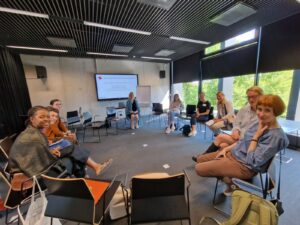MOSAIC partnership is working on the desk research of good practices in Arts & Crafts education, included in Work Package 3. This activity, led by Université Jean Monnet, is collecting useful information on the digitalisation, sustainability and social inclusion activities in the field of Arts and Craft, to identify trends, case studies and map good practices.
The research started in November 2022 and it will end with the next partner meeting in Sofia where the results will be presented. In the meantime, this article will explore some highlights of the research focusing on the Circular Economy in the Italian Art and Craft sector.
One of the Sustainable Development Goals (SDGs), introduced by the UN in 2015, concerns ensuring sustainable consumption and production patterns. In this context, technologies of Industry 4.0 can help in the adoption of sustainable production and consumption, facilitating the transition from a linear to a circular model.
In the Art and Craft sector, circular economy can be achieved by adopting sustainable practices, such as using recycled materials, reducing the use of non-renewable resources, and promoting the repair and reuse of products. The integration of the circular economy and Industry 4.0 can be the turning point for the Art and Craft sector in Italy.
In one of the articles the opportunities and the difficulties experienced by Italian SMEs were analysed with three case studies about one micro and two small companies from Italy’s Marche region, operating respectively in clothing, furniture and shoemaking.
These companies gave some practical examples on the circular approach, namely using renewable or post-consumer sources for production of the products, while waste and processing dust from their activities are collected and sent for recycling. The use of recycled materials can also be optimised using artificial intelligence to identify the most suitable materials for a given product.
Moreover, the economic crisis caused by Covid-19 created new opportunities, by diversifying production and offering customised masks and hygienic holders on the market that attracted consumers.
Also the use of Industry 4.0 technologies could help to make the production process more efficient and cost-effective. For example, during the period of pandemic-related restrictions, one company used Virtual Reality (VR) technology to reproduce a 360° virtual environment to present its collections to consumers. This technology allowed saving money, because producing a sample book for each agent involved high costs and it avoided excessive waste of fabrics and materials.
Conclusions
In conclusion, this article shows that the Art and Craft sector in Italy has a unique opportunity to transform itself by adopting the circular economy and Industry 4.0. By embracing these concepts, artisans and craftspeople can create sustainable products that are more competitive in the global market. This will require a shift in mindset and new skills, which can be developed through vocational education and training programs.
In a few days the results of this desk research will be presented in Sofia and from here partners will move to the next Work Package (WP4) concerning innovative training modules and teaching methodologies.




